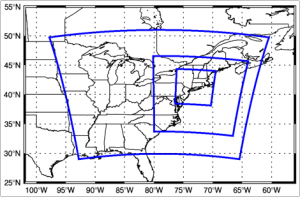High-Resolution Weather Forecasting
Weather fluctuations are anticipated and welcomed across New England, often as an enjoyable aspect of changing seasons. Families and businesses often plan events, travel and daily activities with weather forecasts in mind.
With 90 percent of outages caused by weather impacts on trees, Eversource and UConn put a particular emphasis on enhancing the accuracy of weather forecasts for nearly 18,000 locations across the region. Weather data from National Oceanic and Atmospheric Administration (NOAA) weather observations and regional model forecasts are linked to a state-of-the-art high-resolution weather forecasting system running locally at UConn’s High Performance Computing Lab, enabling the forecasting of real-time meteorological conditions up to three days ahead of a storm.
A related focus area is the UConn Outage Prediction Model (OPM) , which is fed with the high-resolution weather forecast data to forecast a storm’s impact on the electric grid. The OPM is updated every six hours and is a leading-edge approach in the electric industry. Eversource combines the OPM-based forecasted impact with meteorological data to proactively pre-stage crews and accelerate power restorations.
Project Goals and Updates
The scope of this research topic is to improve the reliability of weather forecasts by assessing and characterizing the uncertainty in atmospheric numerical prediction that directly impacts the prediction of outages. Goals include the successful combination of two state-of-the-art atmospheric modeling systems (RAMS/ICLAMS and WRF) that significantly reduce the bias and error in wind speed predictions near the surface (see recent presentation at American Geophysical Union here), development of a freezing/ice/snow rain parameter of Weather Research and Forecasting (WRF) model’s forecasts to facilitate prediction of outages from winter storms (blizzards, freezing rain and ice storms), collaboration with the National Center for Atmospheric Research (NCAR) ensemble forecast team to investigate improvements in the weather forecast and outage predictions.
Implementing a high-resolution weather forecasting system for the Northeast based on the Weather Research and Forecasting (WRF) model and the Regional Atmospheric Modeling System model, and evaluate errors in predicted atmospheric fields during past events of low, medium and high impact;
Applying ensemble forecasting (a numerical weather prediction method that attempts to generate a representative sample of possible future weather) techniques to characterize weather prediction uncertainty and develop an error model for correcting weather forecast error. Accounting for atmospheric model uncertainties in the UConn Outage Prediction Model.




- Our current experience demonstrates an advanced window of 3-5 days is an effective timeframe for reliable weather forecasts. Some variables are easier to forecast in advance, such as temperature.
- Forecast accuracy also depends on weather observations where models are updated at six hour intervals. Some additional uncertainty arises from the unevenly distributed geographic location of weather stations across our region.
- A numerical weather prediction method that attempts to generate a representative sample of possible future weather is termed “ensemble weather forecasting.” This consists of various parallel forecasts issued by differing initial conditions or multiple models and/or configurations to account for uncertainties in imperfect data and methods. The spread among ensemble members represents the forecast uncertainty associated with each set if conditions, and the average of all members is generally more accurate than the forecast from one single member.
Team Members
- Marina Astitha (lead), Assistant Professor of Civil and Environmental Engineering, University of Connecticut
- Emmanouil Anagnostou, Professor of Civil and Environmental Engineering, University of Connecticut
- Diego Cerrai, Assistant Professor of Civil and Environmental Engineering, University of Connecticut
- Xinxuan Zhang, PhD Candidate, Civil and Environmental Engineering, University of Connecticut
- Ummul Khaira, PhD Candidate, Civil and Environmental Engineering, University of Connecticut
- Tasnim Zaman, PhD Candidate, Civil and Environmental Engineering, University of Connecticut
- Israt Jahan, PhD Candidate, Civil and Environmental Engineering, University of Connecticut